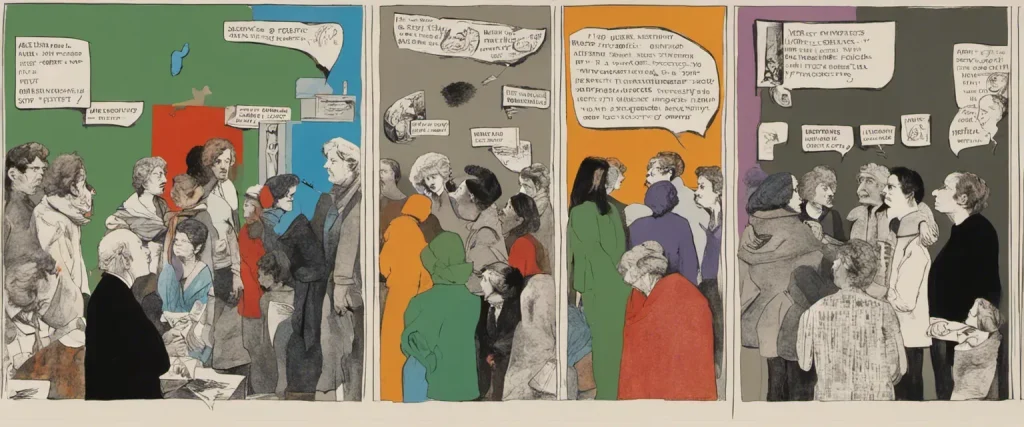In “Ways of Seeing,” acclaimed British art critic John Berger challenges the traditional interpretation of visual images. Through a combination of text and imagery, Berger invites readers to question the underlying meanings embedded in art, advertisements, and other forms of visual media. With his keen observations and thought-provoking insights, Berger revolutionizes the way we perceive and understand the power of images in our society. Born in London in 1926, John Berger was not only a writer but also a painter, novelist, and screenwriter. His wide-ranging artistic background greatly informs his approach to analyzing visual culture, making “Ways of Seeing” an essential read for anyone interested in exploring the complex relationship between society, art, and the act of seeing.
Chapter 1: Introduction – “Ways of Seeing”
Chapter 1 of “Ways of Seeing” by John Berger introduces the reader to the concept of art and the various ways in which it is perceived and interpreted. Berger emphasizes that our ways of seeing are shaped by cultural and social forces, and that art is not a purely objective realm.
He starts by highlighting the impact of technology on the way we see and understand art, explaining that the reproduction and distribution of images have influenced our perception of art throughout history. He argues that the modern age, with its development of mass media and advertising, has inherently led to a loss of the original context and meaning of art. In this way, art has become commoditized, serving multiple purposes beyond its original intentions.
Berger further explores the dichotomy between art and reproduction by illustrating how traditional oil paintings have been consumed primarily by the upper classes while photographs circulated among the masses. This has resulted in a distinction between “nude” and “naked,” where nude refers to the idealized representation of the female form created for the male gaze, while naked represents the reality of the female body.
Moreover, Berger highlights the importance of historical context when analyzing art. He explains that our perception of paintings, for instance, is influenced by cultural conventions and our awareness of the artist’s intentions. He suggests that to fully comprehend a painting, we must consider the historical background and the conditions in which it was created.
In conclusion, Chapter 1 of “Ways of Seeing” establishes the idea that our ways of seeing are subjective and influenced by sociocultural factors. Berger emphasizes the impact of technology and media on our perception of art and urges us to consider historical context when engaging with visual imagery.
Chapter 2: The Language of Images
Chapter 2: The Language of Images of the book “Ways of Seeing” by John Berger delves into the power of images and how they shape our perception of the world. Berger argues that the way we see and interpret images is shaped by our culture and history, and these images ultimately influence how we understand ourselves and others.
Berger begins by highlighting the historical development of oil paintings, stating that this art form became a commodity and a symbol of wealth and power. He asserts that representative paintings, especially those featuring women, were often created to reinforce a particular narrative or ideology.
The author then goes on to discuss the impact of reproduced images, particularly photographs, and how they have transformed the meaning and value of art. He argues that the original context and aura of paintings are lost when they are reproduced, and these images can be manipulated to serve different agendas.
Berger introduces the idea of the “nude” as a genre in art and how it has perpetuated the objectification of women. He explains that the nude is traditionally depicted as an object of desire for the viewer, and the female model’s presence is meant to showcase the artist’s skill and status.
Additionally, Berger explores the dynamics of power and representation in art. He states that the male gaze dominates the way women are portrayed in paintings, resulting in the objectification and subordination of women. He emphasizes that by changing the language and perspective through which we view images, we can challenge and reshape these power dynamics.
In conclusion, Chapter 2 of “Ways of Seeing” highlights how images have been manipulated and used to construct certain narratives and reinforce power dynamics throughout history. Berger encourages readers to critically examine and question the language of images in order to challenge and reshape our understanding of the world.
Chapter 3: The Nude
Chapter 3 of “Ways of Seeing” by John Berger delves into the historical significance of the nude in Western art. Berger highlights how oil painting, as a medium, has played a crucial role in the way society views and understands the female body. The nude has been a subject of art throughout history, particularly in the Renaissance period, and Berger explores how it has been depicted and interpreted by artists.
Berger argues that the tradition of painting the nude female figure has primarily been a tool to objectify and display women as objects of desire for the male gaze. He contends that the depiction of the female nude in art has perpetuated and reinforced societal norms and gender roles.
The chapter also examines the function of the nude male figure in art. Unlike its female counterpart, the male nude is portrayed in a manner that emphasizes strength, power, and dominance. Berger asserts that the male nude has historically functioned as a representation of male authority and control, further perpetuating existing power structures.
Berger challenges the notion that the nude is a timeless form of art by highlighting how the interpretation and portrayal of the female body have been influenced by social, cultural, and historical factors. He emphasizes that the way we see and perceive the nude is conditioned by our societal and cultural conditioning, and that the male gaze has shaped our understanding of the female body.
Overall, Chapter 3 of “Ways of Seeing” critically examines the historical and societal implications of the nude in Western art, shedding light on the power dynamics at play and the objectification of women.
Chapter 4: Publicity

Chapter 4 of “Ways of Seeing” by John Berger focuses on the role of publicity in shaping our perception of the world and ourselves. Berger argues that advertising and publicity have significant control over what we see and how we see it, ultimately influencing our desires and aspirations.
Berger begins by discussing the relationship between publicity and oil painting. He suggests that oil paintings often depict subjects in a way that glorifies their wealth and power, and similarly, publicity images serve to promote the consumption of goods by creating desires and fantasies. The only difference, according to Berger, is that while oil paintings catered to the elite, publicity caters to a mass audience.
One of the key points made in this chapter is that publicity images present an idealized, unrealistic version of reality. By portraying products in an attractive light and associating them with desirable qualities, advertisers manipulate our perceptions and create a sense of lack or desire within us. Berger believes that publicity images only offer us a false promise of fulfillment, as they are detached from the reality of our lives.
Moreover, Berger argues that publicity images also exploit and objectify women. He points out that women are often presented as objects of desire for the male gaze, subtly suggesting that their value comes from their appearance and seductiveness. Consequently, these images reinforce gender stereotypes and perpetuate women’s subordination.
In conclusion, Berger asserts that publicity images are a powerful tool for shaping social, cultural, and personal values. By presenting us with false ideals and manipulating our desires, publicity influences our perception of the world and reinforces societal norms.
Chapter 5: The Heroism of Modern Life
Chapter 5 of “Ways of Seeing” by John Berger examines modern heroism and its connection to the advertising industry. Berger argues that advertising seeks to associate products with a certain lifestyle or image, creating a sense of heroism around consumer culture.
The chapter begins by discussing the historical shift in heroism from religious images to the heroes of capitalism. In the past, religious paintings portrayed heroism as a spiritual or moral virtue, whereas in modern society, heroism is equated with financial success or physical attractiveness. Berger notes that this new heroism ignores virtues such as humility, compassion, and generosity, reducing human worth to mere financial or physical achievement.
Berger then explores how advertising perpetuates this notion of modern heroism. Advertisements often present the consumer lifestyle as glamorous, promising happiness and success through the acquisition of certain products. Images in advertisements focus on wealth, beauty, and pleasure, encouraging viewers to aspire to this unrealistic and shallow version of heroism.
Berger suggests that this manufactured heroism is harmful because it perpetuates social inequality and fosters a culture of materialism and consumption. As people strive to emulate these advertised images of heroism, they become trapped in a cycle of purchasing products that do not genuinely fulfill their desires.
In conclusion, Chapter 5 of “Ways of Seeing” portrays how modern heroism has been distorted by advertising. Berger argues that true heroism should be based on moral values rather than material possessions, and criticizes the advertising industry for promoting an artificial and superficial version of heroism that ultimately undermines human connection and well-being.
Chapter 6: Oil Paintings and Advertising
Chapter 6 of John Berger’s book “Ways of Seeing” delves into the relationship between oil paintings and advertising in order to uncover the ways in which both mediums manipulate and influence how we see and interpret the world.
Berger begins by examining the historical significance of oil paintings and how they have traditionally been used to depict wealth, power, and social status. He argues that these paintings were commissioned as a means of displaying the possessions and achievements of the ruling classes. However, Berger suggests that these artworks are not mere representations of reality but instead carry with them an inherent bias and ideology.
Moving on to advertising, Berger explores how the medium utilizes similar techniques to oil paintings in order to convey certain messages and persuade the viewer. He highlights how advertisements use images of luxurious products, beautiful people, and glamorous lifestyles to create desire and sell products. Additionally, he underlines the illusionary nature of these images, as they are carefully constructed, manipulated, and manipulated to deceive the viewer into believing that owning these products will bring happiness and fulfillment.
Berger exposes the subtle ways in which both oil paintings and advertising manipulate our perception by creating a false reality. He emphasizes that these mediums create a visual hierarchy, where certain subjects are valued more than others, perpetuating societal divisions and inequalities.
In conclusion, Chapter 6 of “Ways of Seeing” reveals the underlying similarities between oil paintings and advertising, exposing them as powerful tools that shape how we see and understand the world. Both mediums employ visual manipulation and construct a false sense of reality, influencing our desires and perpetuating social hierarchies.
Chapter 7: Women as Objects
Chapter 7 of John Berger’s book “Ways of Seeing” explores the representation and portrayal of women in art history and the media. Berger argues that women have often been objectified and reduced to their physical appearance, serving as passive objects for the male gaze.
Berger begins by analyzing the traditional Western art of the nude female figure. He suggests that these paintings were primarily created for the pleasure of the male viewer, perpetuating the idea that a woman’s value lies in her appearance. Additionally, Berger observes that women in these works are often portrayed as passive, vulnerable, and there solely for the male gaze.
Moving beyond art, Berger also explores the role of advertising and the media in objectifying women. He contends that modern advertising uses images of women to sell products by creating an association between female beauty and consumer goods. Berger suggests that this manipulative tactic not only reinforces objectification, but also perpetuates the idea that women should strive to fulfill an idealized and unattainable beauty standard.
Furthermore, Berger critiques the practice of objectifying women through clothing. He argues that women are often pressured to conform to societal expectations of fashion and appearance, reducing their sense of individuality and perpetuating the notion that they are objects to be observed and judged.
In conclusion, Chapter 7 of “Ways of Seeing” serves as a powerful critique of the objectification of women in art, advertising, and society as a whole. Berger highlights how women have historically been reduced to objects for the male gaze, and argues for a more nuanced understanding of women as complex individuals rather than passive objects of desire.

Chapter 8: Conclusion – “How to Look at a Painting”
In Chapter 8 of “Ways of Seeing” titled “Conclusion – How to Look at a Painting,” John Berger emphasizes the importance of actively engaging with art and challenges traditional ways of viewing paintings. He argues that art should be seen as a product of social and historical contexts rather than being clouded by established notions of beauty and value.
Berger suggests that the traditional way of looking at paintings is often influenced by museums, galleries, and art history that perpetuate an elitist perspective. He highlights how these institutions often separate art from its original purpose and function, rendering it mere objects of contemplation. Berger asserts that the economic and social transformations throughout history have impacted how art is perceived, bought, and sold, and this consequently diminishes the authentic experience of viewing a painting.
Moreover, Berger points out the contradiction between the solitude with which paintings are traditionally viewed and their original intention to be shared within a community. He argues that art has been commodified and used to establish cultural dominance, thus distancing viewers from its true significance.
In order to counteract these issues, Berger proposes a more active approach to looking at paintings, where the viewer interacts with the artwork instead of passively observing it. He encourages viewers to analyze the context, subject matter, style, and technique employed in the painting to better understand its meaning and purpose.
Overall, Berger concludes that art should not be limited to the aesthetics and appreciation by a specialized few but should be accessible to everyone. By actively engaging with paintings and questioning established norms, individuals can rediscover the power of art to challenge dominant ideologies and facilitate social change.
After Reading
In conclusion, “Ways of Seeing” by John Berger is a thought-provoking and insightful book that challenges traditional notions of art and perception. Berger’s exploration of the power dynamics behind art and how it shapes our perspective sheds light on the hidden biases and commercial interests that govern the way we see and interpret images. By dissecting the various forms of art and media, Berger encourages readers to question their own preconceptions and to recognize the multiple layers of meaning embedded in visual culture. Through his engaging analysis, Berger invites us to critically examine the ways we view and understand art, urging us to reclaim our agency in interpreting the complex interplay between images, society, and individual perception. Overall, “Ways of Seeing” is an important and enlightening read that encourages us to look beyond the surface and actively participate in the creation of meaning.
1. Towards a New Architecture by Le Corbusier
Le Corbusier, one of the pioneers of modern architecture, contemplates the future of urban planning and design in this influential book. Exploring concepts such as functionality, efficiency, and the importance of light and space, Corbusier presents a vision that revolutionized the field. Through his manifesto-like writing style, readers gain insights into the principles that shaped contemporary architecture.
2. The Non-Designer’s Design Book by Robin Williams
If you’ve ever been daunted by the prospect of designing something visually appealing, this book is the perfect guide. Robin Williams simplifies design principles and techniques, enabling individuals with little to no design background to create impactful visuals. Exploring a range of topics, such as typography, color theory, layout, and more, this book empowers readers to enhance the aesthetics of their work across various mediums.
3. What Are You Looking At? by Will Gompertz
After delving into John Berger’s Ways of Seeing, embark on a journey through art history with Will Gompertz’s engaging exploration. Gompertz guides readers through the incredible transformations that art has undergone, unveiling the revolutionary movements and iconic artists who paved the way. With a blend of captivating stories and insightful analysis, this book allows readers to appreciate art in new and thought-provoking ways.
4. The Architecture of Happiness by Alain de Botton
For those inclined towards both architecture and philosophy, Alain de Botton unravels the relationship between the built environment and human emotions. By examining various architectural styles, de Botton reveals how our surroundings significantly impact our well-being and sense of contentment. This illuminating book encourages readers to reflect on the spaces they inhabit and appreciate the inherent beauty and meaning in architecture.
5. The Visual Display of Quantitative Information by Edward R. Tufte
In a world where data visualization is crucial, Edward R. Tufte’s book provides invaluable insights on presenting information effectively. With numerous examples and case studies, Tufte explores the art of visualizing data and its potential to communicate complex concepts seamlessly. Whether you’re a data analyst, designer, or simply interested in presenting information clearly, this book will enhance your understanding of visual communication.




Comments
Aziel Finley